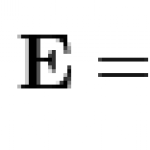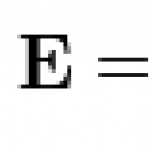
At this rate I should change the name of this feature to Monday Function, but with any luck I can get my weekend schedule back to something approaching normal and break this streak of late SFs. But hey, every day is a good day for math.
This function is one we can define in a piece-by-piece way. It's equal to zero everywhere except near the origin. Between -1/2 and 1/2, it's just equal to 1. As such it's just a rectangle hanging out at the middle of the number line.
The area of this rectangle is just its base times its height, or in this case 1 * 1 = 1. This isn't the only way to get a…
What do we think about nuclear power? Benjamin Cohen of The World's Fair is not a fan. I am.
Modern nuclear power has a lot going for it. In no particular order, here's the reasons that appeal to me.
It's reliable. No worrying about solar or wind availability, and it works anywhere.
It's safe. Modern nuclear plants designs are extraordinarily safe, and frankly even the old first-world designs are very safe. The worst accident - Three Mile Island - didn't kill anyone. The spectre of Chernobyl haunts the public discourse, but Chernobyl is to modern nuclear power as bloodletting is to…
"Why is the sky blue?"
It's one of those questions that most people don't know the answer to, while others know at least the basic explanation that the atmosphere scatters blue light more strongly than the other visible wavelengths. Ask why that happens and you'll enter the realm of some interesting and somewhat complicated physics. We'll do that later, and do an easier one today.
Kids sometimes also ask why water is blue. The most common answer is that it isn't - the blue of the ocean is attributed to reflected sky or something similar, while the water itself is clear. There's some truth…
Anybody still read newspaper comics these days? I do, but sadly for the newspaper business I read them online. Worse, usually in the context of people making fun of them. On the other hand, there are a few gems out there. Is Spider-Man one of those gems? Uh...
Well, Shakespeare it ain't. But is Spider-Man justified in his optimism about being able to catch Mary Jane? If Doc Ock just drops her instead of throwing her (as he seems to suggest), she'll start with zero velocity and immediately begin to accelerate at 9.8 meters per second squared vertically downward. As soon as Spider-Man…
This guy is Allo Diavolo:
He was a circus daredevil. At the dawn of the 20th century he worked on a number of stunts dressed in his ominous horned outfit. These days a lot of people, including me, have heard of him as an example in the pages of physics textbooks. In my case it was Halliday and Resnick, a standard (and good) freshman physics text. Diavolo did a trick where he looped the loop riding a bicycle. It's pretty impressive:
The breathless circus ad copy claims that this stunt is more or less certain death. It wasn't, of course. I wouldn't want to try it, but it's certainly a…
I think we've developed a nice theme over the last few weeks, gradually working our way through a less well-behaved function - the triangle wave - and trying to find various series expansions for it. "Well-behaved" is kind of a term of art, which mathematicians use as shorthand for long strings of caveats about differentiability and continuity and which physicists use because who wants to memorize those long strings?
Well, to some extent we have to. While it's not very common that badly-behaved functions arise in physics, there are functions which at least don't always remember to say…
We've seen that it's pretty easy to determine your latitude using the sun as a reference point. All you need is a shadow and chart that was easily available to sailors of previous centuries and you're set. Finding your longitude is another story. The reason for the difference in difficulty is one of time. The sun varies very little in its north-south position from day to day, but it varies enormously in its east-west position by virtue of the whole "rising and setting" thing. It's easy to look up on a chart to find a correction factor that varies day-by-day, but when you need a…
Holy moly, if you want to see a great post you should read Ethan's post on the solar analemma. If you photograph the sun in the sky at the same time each day, it won't be in the same spot. The orbital motion of the earth, your location on the curve of the earth, and the tilt of the earth's axis causes the sun to appear in slightly different locations each day and the path it traces out is sort of a figure-8 called an analemma.
Is it just a mathematical curiosity? Well, mostly yes other than to astronomers. But this was not always so. If you were an 17th century sailor plying your trade…
Not much meat here at the Built on Facts table today. Our research group is embarking on a new project with the Office of Naval Research, and today was the official all-day meeting with the officer in charge of coordinating the various projects in his part of the ONR funding structure. We've spent a lot of time getting everything ready, and based on what I saw today I think the research is going to open up a lot of new, interesting, and important territory. Plenty of good blog post material, too.
I'll fill in some of the details later on, though of course a lot of it will have to wait…
Sorry for the two-day delay. The personal business to which I alluded kept me out until yesterday morning, delaying this post until today. I hope it's decent for all that!
This week, the same function as last week. There's nothing so special about the function itself, but it does serve as a nice Rorschach blot to project our own wandering mathematical thoughts upon. As with last time, the specific "f(x) = stuff" form of the function is not particularly enlightening. It's just a few lines tacked together. The graph is all we need.
Last time we set ourselves the task of writing this…
In the last post I made an offhand mention of wave dispersion, which is the phenomena of different wavelengths propagating a different speed. In general this does exactly what it sounds like it should. It disperses the light. If you start off with a tightly grouped bunch of runners, the pack will spread out as soon as they start running and the fast ones pull away and the slow ones get left behind.
If you're a physicist and your paycheck comes from making tightly-bunched pulses of light, this is a pain in the neck. You perform miracles of science with beautiful and tremendously expensive…
All right, the answer to yesterday's question about the maximum speed of a stadium wave, as many commenters rightly said, is "as fast as you want." The comments went into some depth on this, and I like the way Zifnab put it:
I mean, if you've got two independent agents doing their thing, the "speed" between the two just gets faster the farther apart they are. But if they have no relation to one another... what are we even asking? If our imaginary stadium is the size of the Milky Way Galaxy and the seats are stars and you stand up on Alpha Centari and I stand up on the Sun less than 4 years…
The wave. We've talked about it before. It's where people in a stadium stand up and sit down in sequence so that a wave of standing people travels around the circumference of the stands.
They have a typical speed of around 12 m/s, though it is by no means entirely universal. You could certainly imagine a crowd being instructed to go much faster or slower when doing the wave, and though I never done seen it I don't think it would be very difficult.
If you had a truly enormous imaginary stadium, maybe one with hundreds of thousands of miles of bleachers and an audience to match, you could…
Let's say there's an interesting but somewhat obscure book I'm interested in. Say, Electromagnetic Pulse Propagation in Causal Dielectrics. It's a very technical work about a very specific subject, so the total print run was probably very small. Maybe a few hundred or a thousand or so? I have no idea, but it can't be very large.
The library has it, but of the few thousand people in the world who are interested in this sort of thing, a few dozen are here at Texas A&M. The book is already both checked out and recalled; for all I know there's recall requests stacked several deep. Now…
There's an interesting book I'm working on called The Fall of Rome: And the End of Civilization, by historian Brian Ward-Perkins. He argues (against a prominent modern school of thought) that Rome did indeed fall rather than merely change, and that European civilization really was wrecked pretty hard with a recovery that by many fairly objective numerical metrics took almost a thousand years to reach its former level of economic complexity and living standards. It wasn't a fast and sharp break separating the Roman from post-Roman world, but it was in fact a break.
You can make a similar…
Today I bought a sandwich at Subway. 12" ham on "Italian herbs and cheese" bread, American cheese, lettuce, tomatoes, bell peppers, sweet onion sauce. After tax, the cost was $5.41. I handed a $10 bill to the young guy behind the register. By young I'm guessing 18ish.
As such I was going to get $4.59 in change. His change drawer was pretty much empty, and so while he was getting more change I fished around in my pocket for another penny so as to keep the number of coins to a more manageable 3 total. I offered the penny.
By now you've heard the story before. He apologetically said he'd…
And God said, Let there be light: and there was light.
- Genesis 1:3
This post is going to need the standard math disclaimer. Though there's math that looks horrible, you don't actually have to know any math to follow the ideas. Give it a try!
Over this week we've looked at the four Maxwell equations that describe the entirety of classical electromagnetism. Let's write them all down:
These four are everything that it's possible to know about the classical behavior of electromagnetic fields. This notation is a little more modern than what Maxwell originally wrote down in the 1860s, but…
Fundamentally Maxwell's equations describe the origins of electric and magnetic fields. Given a set of conditions on the right hand side of the equations, you'll have fields described by the left hand side. Between the four equations the fields are uniquely specified, and there is nothing more to include. Thus far we've seen electric fields generated by electric charge, electric fields generated by changing magnetic fields, and magnetic fields not generated by magnetic charge because there isn't any. Conspicuously absent is any way to generate magnetic fields. It is this fourth equation…
So far we've seen that electric charges create electric fields. We've also seen that magnetic charges would create magnetic fields if there were any such things, but there aren't. If you're in the business of creating electric fields, as the entire electric power industry is, one way of doing so is to pile up a bunch of charge. This is a massive pain and is usually impractical to provide the EMF necessary to shove those electrons through our home electrical outlets. But since there is in fact current flowing through those wires, there must be another way to get electric fields.
There is…
In our examination of the first of Maxwell's four equations, we saw that magnetic charge doesn't exist as far as we can tell. On the other hand, electric charge permeates every aspect of our existence. The motion of charged electrons is one of the central pillars of modern civilization. The way that electric charge creates an electric field is the subject of the second of Maxwell's equations. In its full mathematical glory:
The triangle and the dot represent the divergence, exactly as in the first Maxwell equation. The letter E is the electric field. Unlike the magnetic field…














